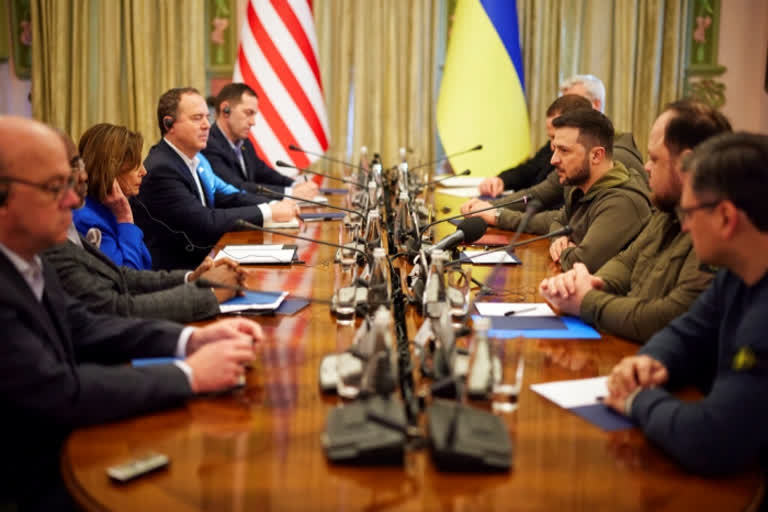Zaporizhzhia: A long-awaited evacuation of civilians from a besieged steel plant in the Ukrainian city of Mariupol was under way Sunday, as U.S. House Speaker Nancy Pelosi revealed that she visited Ukraine's president to show unflinching American support for the country's defense against Russia's invasion. Video posted online by Ukrainian forces showed elderly women and mothers with small children bundled in winter clothing being helped as they climbed a steep pile of debris from the sprawling Azovstal steel plant's rubble, and then eventually boarded a bus. Ukrainian President Volodymyr Zelenskyy said more than 100 civilians, primarily women and children, were expected to arrive in the Ukrainian-controlled city of Zaporizhzhia on Monday.
"Today, for the first time in all the days of the war, this vitally needed (humanitarian) corridor has started working," he said in a pre-recorded address published on his Telegram messaging app channel. The Mariupol City Council said on Telegram that the evacuation of civilians from other parts of the city would begin Monday morning. People fleeing Russian-occupied areas in the past have described their vehicles being fired on, and Ukrainian officials have repeatedly accused Russian forces of shelling evacuation routes on which the two sides had agreed. Later Sunday, one of the plant's defenders said Russian forces resumed shelling the plant as soon as the evacuation of a group of civilians was completed.
Denys Shlega, the commander of the 12th Operational Brigade of Ukraine's National Guard, said in a televised interview Sunday night that several hundred civilians remain trapped alongside nearly 500 wounded soldiers and "numerous" dead bodies. "Several dozen small children are still in the bunkers underneath the plant," Shlega said. "We need one or two more rounds of evacuation." Sviastoslav Palamar, deputy commander of the Azov Regiment, which is helping defend the steel plant, told The Associated Press in an interview from Mariupol on Sunday that it has been difficult even to reach some of the wounded inside the plant.
"There's rubble. We have no special equipment. It`s hard for soldiers to pick up slabs weighing tons only with their arms," he said. "We hear voices of people who are still alive" inside shattered buildings. As many as 100,000 people may still be in blockaded Mariupol, including up to 1,000 civilians hunkered down with an estimated 2,000 Ukrainian fighters beneath the Soviet-era steel plant — the only part of the city not occupied by the Russians. Mariupol, a port city on the Sea of Azov, is a key target because of its strategic location near the Crimea Peninsula, which Russia seized from Ukraine in 2014.
U.N. humanitarian spokesman Saviano Abreu said civilians who have been stranded for nearly two months at the plant would receive immediate humanitarian support, including psychological services, once they arrive in Zaporizhzhia, about 140 miles (230 kilometers) northwest of Mariupol. Mariupol has seen some of the worst suffering. A maternity hospital was hit with a lethal Russian airstrike in the opening weeks of the war, and about 300 people were reported killed in the bombing of a theater where civilians were taking shelter. A Doctors Without Borders team was at a reception center for displaced people in Zaporizhzhia, in preparation for the U.N. convoy's arrival. Stress, exhaustion and low food supplies have likely weakened civilians trapped underground at the plant.
Also read:Ukrainians plead for Mariupol rescue; Russian advance crawls
Ukrainian regiment Deputy Commander Sviatoslav Palamar, meanwhile, called for the evacuation of wounded Ukrainian fighters as well as civilians. "We don't know why they are not taken away, and their evacuation to the territory controlled by Ukraine is not being discussed," he said in a video posted Saturday on the regiment's Telegram channel. Video from inside the steel plant, shared with The Associated Press by two Ukrainian women who said their husbands were among the fighters refusing to surrender there, showed men with blood-stained bandages, open wounds or amputated limbs, including some that appeared gangrenous. The AP could not independently verify the location and date of the video, which the women said was taken last week.
